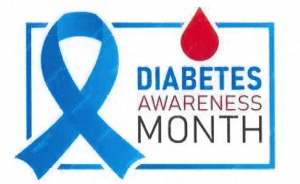Subscribe to Stay Informed
NOVEMBER DIABETES AWARENESS MONTH
Posted 09/10/25
 Diabetes Awareness Month is observed in November each year. It will focus on raising awareness about diabetes, educating the public on its risks, prevention, and management, and celebrating the risilience of those living with the condition. The American Diabetes Association will host various events and campaigns throughout the month to promote diabetes awareness and support.
Diabetes Awareness Month is observed in November each year. It will focus on raising awareness about diabetes, educating the public on its risks, prevention, and management, and celebrating the risilience of those living with the condition. The American Diabetes Association will host various events and campaigns throughout the month to promote diabetes awareness and support.
November 14th is World Diabetes Day and is recognized around the globe
What is Diabetes: Diabetes is a chronic condition characterized by high levels of glucose in the blood. It occurs when the body either cannot produce enough insulin, a hormone that regulates blood sugar, or cannot effectively use the insulin it produces. This can lead to various health complications if not managed properly.
There are 3 main types of diabetes
- Type 1 Diabetes: is a lifelong disease caused by the autoimmune destruction of insulin-producing islet cells (beta cells) in the pancreas. Insulin is a hormone that the body needs to metabolize glucose (blood sugar), a key source of energy. Without insulin, no cell in the body can use or store glucose normally. The destruction of islet cells leads to a loss of insulin production and abnormal glucose regulation, often leading to high glucose levels in the blood, know as hyperglycemia. The sypmtoms include, increased thirst, frequent urination, unexplained weight loss, and presence of ketones in urine.
- Type 2 Diabetes: is a chronic condition that affects the way your body processes blood sugar (glucose). It primarily results from two issues: the body's cells do not respond properly to insulin, and the pancreas does not produce enough insulin to maintain healthy blood sugar levels. If not managed properly, it can lead to serious health complications, including heart disease, nerve damage, and kidney problems. While there is no cure, type 2 diabetes can be managed through lifestyle changes, medication, and regular monitoring of blood sugar levels. Symptoms are similar to type 1, including increased thirst, frequent urination, fatigue, blurred vision, and slow-healing sores.
- Gestational Diabetes: is a diabetes that is first diagnosed during pregnancy. It occurs when the body cannot produce enough insulin to meet the increased demands during pregnancy, leading to elevated blood sugar levels. This condition typically develops around the 24th to 28th week of pregnancy and may not cause noticeable symptoms. The symptoms include, frequent urination, excessive thrist, Tiredness and nausea.
Tests Commonly Used to Diagnose Diabetes:
A1C Test: this is a blood test that measures the average blood sugar (glucose) levels over the past two to three months. It indicates what percentage of hemoglobin in the blood is coated with sugar, also known as glycated hemoglobin. Higher A1C levels suggest poorer blood sugar management and an increased risk of diabetes related health issues. This test is commonly used to diagnose diabetes and to monitor how well a person is managing their diabetes.
Fasting Plasma Glucose Test: Measures blood sugar after fasting for a least 8 hours.
Oral Glucose Tolerance Test: Measure blood sugar before and after drinking a sugary solution.
Random Plasma Glucose Test: Measures blood sugar at any time, regardless of when you last ate.
These tests help determine if you have diabetes or are at risk of developing it.
If you would like anymore information go to the American Diabetes Association website
So for the month of November please wear blue in support of those who suffer with Diabetes.
